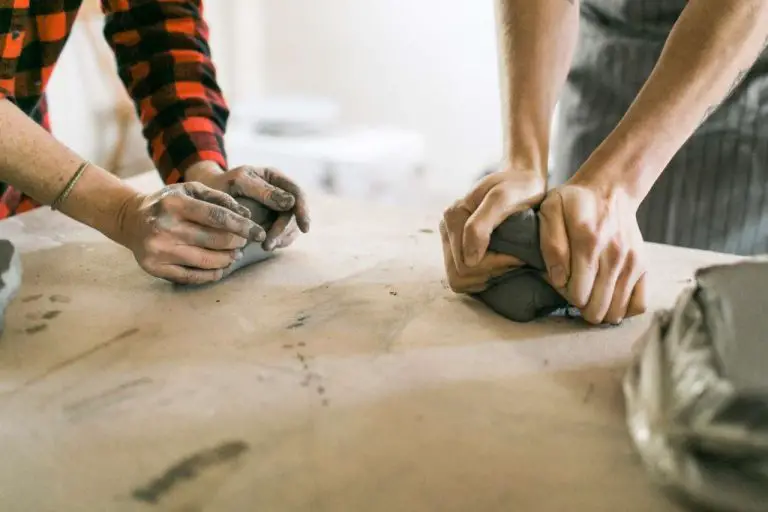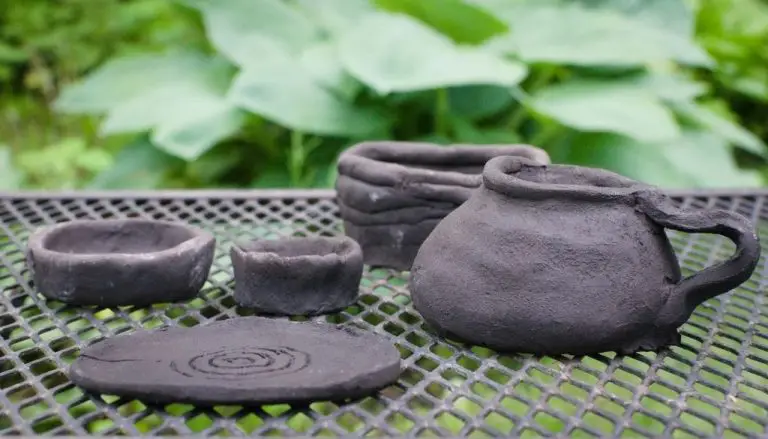What Process Gives The Clay This Red Color?
Clay is an ancient and versatile material that has been used by humans for thousands of years. The term clay refers to a naturally occurring material composed primarily of fine-grained minerals such as silica, alumina, and iron oxide. Clay occurs in a variety of colors including white, yellow, red, brown, grey, and black. The natural color of clay depends on its mineral composition and the presence of impurities. Of all the clay colors, red clay stands out due to its vivid and distinctive hue.
Red clay gets its name from the red-orange color it develops when fired under high heat. This unique color comes from the presence of iron oxide, which acts as a natural pigment. Iron oxide, commonly known as rust, coats the clay particles and causes them to turn red when exposed to air and high temperatures. The amount of iron oxide present determines the depth of the red color. Red clay with higher iron content will develop a deeper, richer red tone.
Beyond its colorful appearance, red clay is an important material valued for its properties and uses across many cultures and industries. This includes applications in pottery, construction, medicine, cosmetics, engineering and more. The following sections will explore the composition, properties and uses of this distinctive clay in further detail.
Composition of Clay
Clay is composed primarily of fine-grained minerals including silica, alumina, and water. Silica and alumina make up a majority of the clay’s mass, while water fills the spaces between the mineral particles.
Other minerals present in smaller quantities contribute color and texture. Iron oxides create red, orange, and yellow hues. High iron content produces red and brown clays. Magnesium oxides make clays fire to buff and pink tones. Carbon compounds produce gray and black clays. The mineral composition determines the clay’s properties when fired.
Iron Oxide
Iron oxide is the main pigment that gives red clay its distinctive color. It is formed when iron is exposed to oxygen. The iron oxidizes and produces iron oxide compounds that vary in color from yellowish red to deep brick red.
The specific shade of red depends on the mineral composition of the iron oxide. Common iron oxide minerals found in clay include hematite, magnetite, and maghemite. Hematite produces a vivid red color, while magnetite is black or deep purple-red. Maghemite results in a more muted and earthy red-brown shade.
The concentration and type of iron oxides present in the clay determine the depth of red coloration. Clays with high iron oxide content and a dominance of hematite tend to be a vivid, rich red. As the iron oxide concentration decreases, the red color becomes lighter and more orange in hue.
Firing Process
The most important step in producing the signature red color of clay is the firing process. Clay that contains iron oxide is placed into a high temperature kiln or oven, generally ranging from 1,800 to 2,400 degrees Fahrenheit. As the temperature rises inside the kiln, a chemical change occurs in the iron compounds within the clay. Iron oxides like hematite and magnetite are transformed into new red iron oxide compounds like maghemite and hematite-maghemite. This chemical reaction enhances the vibrancy and intensity of the red color. The longer the clay is fired and the higher the heat, the richer the resulting red hue. Well-fired red clay develops a deep, saturated color with a smooth even finish. The firing process essentially “activates” and brings out the latent red color that was always present in the raw clay’s mineral composition.
Clay Deposits
Red clay gets its distinctive color from iron oxide content. Deposits of red clay are found largely where high iron content occurs in the soil. Major deposits of red clay are located in North America, Europe, Africa, and Asia.
In North America, rich red clay is found extensively in the southeastern United States. The states of Georgia, Alabama, Mississippi, and Tennessee contain abundant iron-rich clay that gives the soil a deep red hue. Similar deposits occur along the Gulf Coast states. Midwestern states including Illinois and Ohio also contain valuable red clay deposits.
Europe is home to major clay and mineral deposits that have supplied pigments and clay products since ancient times. Rich red clay deposits are found throughout the British Isles and in continental locations including France, Germany, Russia, Italy, and Spain. The Mediterranean island of Sardinia contains iron-rich clay deposits that have been mined since prehistory.
Africa’s red clay deposits occur mainly in the north and west. Morocco and Tunisia contain iron-rich clay used for local pottery and building materials. West African countries such as Ghana, Burkina Faso, and Mali have clay and mineral resources. Madagascar off the southeast coast has substantial red clay deposits.
In Asia, abundant iron-rich clays are found in India, Thailand, Vietnam, and China. The “Terracotta Warriors” funerary statues were made with red clay from Xi’an, China. Historic and modern pottery industries in Asia rely on the ready availability of iron-rich clay.
Properties of Red Clay
Red clay has unique properties due to its higher iron oxide content compared to other clays. The increased iron content changes the physical characteristics of the clay in several key ways:
Higher hardness – The iron oxide physically strengthens the clay, making it more durable and resistant to wear and abrasion. Red clay items maintain their structure better than less iron-rich clays.
Improved heat resistance – The iron oxide allows red clay products to withstand higher temperatures before softening. Items like bricks and pottery can be fired at hotter kiln temperatures.
Increased stability – The strong molecular bonds in iron oxide help the clay hold its shape. When wet, red clay is less prone to slumping or deforming compared to clays low in iron.
These properties make red clay well-suited for high-temperature applications like pottery and brick production where durability and heat resistance are important.
Uses of Red Clay
Red clay has been utilized by humankind for thousands of years in a variety of applications thanks to its unique physical and chemical properties. Some of the most common uses of red clay include:
Pottery
Red clay is one of the most popular types of clay for making pottery due to its excellent plasticity and workability. The high iron oxide content in red clay enables it to vitrify at relatively low temperatures, making it ideal for firing pottery. Red clay-based pottery tends to have a terracotta color and is found throughout history across many cultures.
Bricks
Clay bricks have been a staple of construction for millennia. Red clay produces strong, durable bricks due to the high iron oxide content. When fired, the bricks obtain their iconic red or orange hue. Modern brick manufacturing often mixes red clay with other additives to optimize technical properties.
Roof Tiles
Fired roof tiles made of red clay are an ancient and still popular roofing material in many parts of the world. The tiles lend a distinctive Mediterranean or Spanish architectural flair. Red clay’s low thermal conductivity helps regulate interior temperatures.
Pigments and Paints
Various shades of red ochre pigments can be produced from red clay deposits that contain iron oxides. These vivid pigments have been used since prehistoric times in cave paintings, murals, and to color paints. Natural red ochre is still used by artists today.
Engineering Applications
Modern civil engineering uses red clay for a variety of applications. The clay can help line landfills and mining tailings ponds. It is also used to manufacture lightweight bricks and as a stabilizer or filler material for road and airport runway construction.
Other Colors of Clay
In addition to the common red clay, clays can also be found in white, yellow, and blue varieties. The color of the clay depends on its mineral composition:
White Clay
White clay, also known as kaolin or china clay, is composed mainly of kaolinite. It contains very little iron oxide and is formed when other clays weather away. White clay fires to a white or near white color.
Yellow Clay
Yellow clay contains iron oxide and magnesium. It has a high silica and alumina content which gives it a fine texture. When fired, yellow clay can range from pale yellow to deep orange in color.
Blue Clay
Blue clay gets its distinctive color from containing minerals like ilmenite and rutile. It fires to a grayish blue tone. The deep blue color is highly prized in pottery making.
In summary, while red clay’s signature hue comes from iron oxide, other clay colors stem from their unique mineral makeups. The varying compositions yield an array of clay types ideal for different applications.
History of Red Clay Use
Red clay has been used to create pottery and art for thousands of years. Evidence of early red clay pottery has been found in many ancient cultures across the world.
In ancient Egypt, red clay was used to make pottery and bricks as early as 4000 BC. The ancient Egyptians developed a robust pottery industry using the red clay deposits along the Nile river to produce all kinds of vessels and containers.
The people of the Indus Valley civilization, located in modern day Pakistan and northwest India, produced red clay pottery beginning around 3300 BC. They created many kinds of pottery items including bowls, jars, sculpture and more.
In ancient China, pottery made from red clay dates back over 10,000 years ago to the Neolithic period. Chinese red clay pottery developed over thousands of years into the famous Terracotta Army sculptures as well as utilitarian and decorative ceramics.
The ancient Greeks and Romans also produced large quantities of pottery and ceramics from red clay. Greek red figure pottery was a distinctive style marked by decorative red figures on a black background. The Romans industrialized pottery production and spread red clay pottery across their empire.
Various Native American cultures also have a long history of using local red clay for pottery and sculpture. From the Anasazi in the Southwest to tribes along the Mississippi River, red clay was an important material for creating lasting works of art.
Conclusion
To summarize, the red color in clay comes from iron oxide. Iron oxide is a common compound found in clay deposits around the world. When the iron-rich clay is fired at high temperatures, the iron oxide undergoes a chemical change and turns the clay red. The percentage of iron oxide and the firing method determine the intensity of the red color.
The distinct red tones of iron-rich clay have been prized across cultures and history. From prehistoric pottery to modern brick architecture, red clay’s vibrancy, durability, and availability have made it an indispensable material for centuries. The fiery reds and earthy oranges of iron oxide bring warmth and life to both functional and decorative clay objects. As an abundant and versatile material, red clay will likely continue to be an essential natural resource for human creativity.





